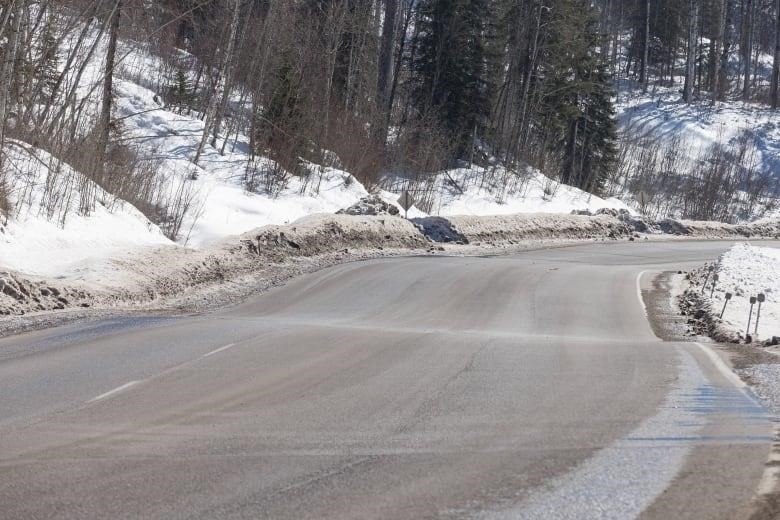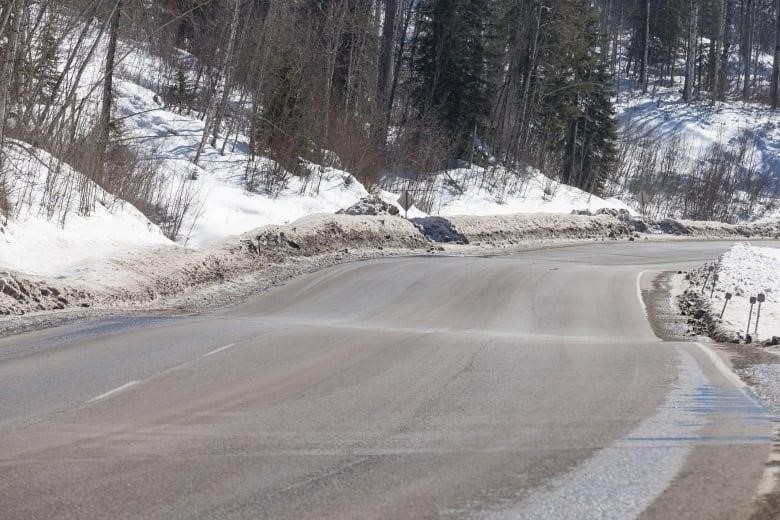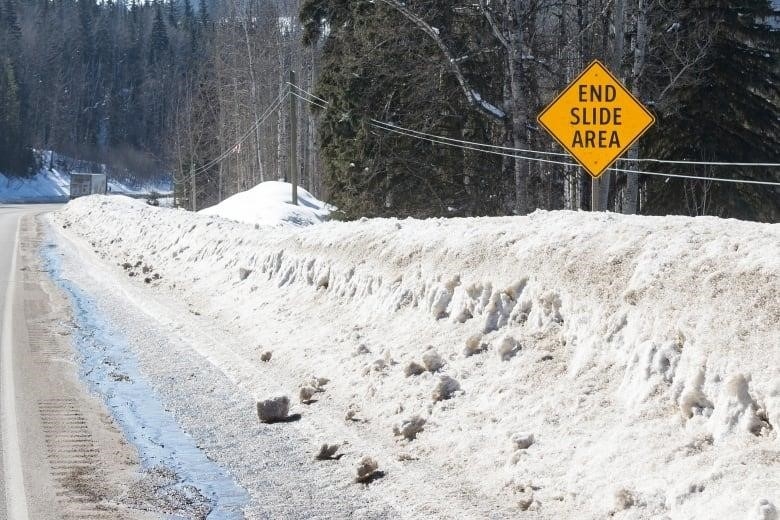
The B.C. government says that a series of old landslides have “woken up” in the Cariboo region, costing the federal government hundreds of millions of dollars in disaster aid.
The province says that climate change is to blame for the slides coming back to life, but experts say the problem is caused by logging in the area.
In the springs of 2020 and 2021, slow-moving landslides and flooding washed out roads around Quesnel, B.C., where geotechnical studies have also found a link between ongoing land movement under hundreds of homes and slow-moving landslides from the past.
A document obtained through a freedom of information request shows how expensive the problem is. It says that the B.C. government estimated that the damage caused by the landslides in the Cariboo would be eligible for $995 million in federal disaster aid.
In December 2021, the briefing note was made for B.C. Minister of Public Safety Mike Farnworth.
When asked about the estimate, B.C.’s Ministry of Emergency Management said that the province has already received $405 million in advance payments from Ottawa to help with rebuilding.
On a B.C. government website, “unprecedented slides and road washouts” in the Cariboo are blamed on wildfires and changes in weather patterns caused by climate change. The old slides have been “reawakened” and “reactivated,” the website says.
But Younes Alila, a professor of forestry at the University of B.C., says that the forest loss caused by extensive logging, mountain pine beetle infestations, and wildfires is a major cause of the hydrological changes that led to the slides.
Alila said he is worried that money spent on rebuilding roads will be wasted if officials and engineers don’t take that into account.
“I think the government could make much better decisions in the future if they knew and admitted what caused the landslides and flooding,” he said.
Although approval of logging that some link to the landslides was a provincial responsibility, it is the federal government that bears the bulk of the disasters’ costs. Under assistance rules cited in the briefing note, 90 per cent of the costs are borne by Ottawa if the price tag for a disaster in B.C. cost more than $85 million.
Others worry, like Alila, that logging has caused widespread changes in the way water flows.
Mike Morris is the B.C. Liberal member of the legislature for Prince George-Mackenzie and former public safety minister said that the provincial government should treat hydrological changes caused by forest loss as “one of the most high-risk situations in the province.”
“And, to be honest, they’re not.”

‘Slope stability 101
The former mayor of Quesnel, Bob Simpson, said that “massive clearcuts” from salvage logging had changed the way water moved through the area.
The former New Democrat MLA said, “Anyone who thinks otherwise is living in La La Land.”
Alila’s research focuses on watersheds in the interior of the province. She said that without forests to control how much snow melts in the spring, soils get too wet more often and the water table stays high for longer.
“The soil starts to cave in when the groundwater pressure goes above a certain level more often and for a longer time,” said Alila, who is also a professional engineer.
“This is first-year slope stability.”
A statement from the Forests Ministry said, “the impact of proposed forestry operations regarding ground saturation and land stability is always part of the overall permitting approval process.”
It was said that the loss of forest cover can change the way water flows in a watershed, but no specific areas were named. The province said that this can be caused by harvesting, but that “any disturbance” that reduces the amount of vegetation can also make the risk of flooding higher.
“One of the best ways to reduce the risk of landslides is to quickly reforest areas that have been cut down or damaged by wildfires or pests, and to deal with the effects of climate change,” the ministry said.
WATCH | Climate change makes landslides a growing danger for B.C. Interior, say the experts:
Alila said that climate change is being used as a “scapegoat,” and that replanted forests take decades to recover their hydrological function.
“The fact is that both climate change and changes in how land is used and covered make these extremes worse in size, frequency, and length,” he said, referring to landslides, flooding, and drought in B.C. and further.
He said that it is clear that the Cariboo landslides are a regional problem, and that other than changes in rainfall, the only other possible regional cause is the loss of forest cover.
But Alila rules out precipitation because science shows that climate change is making the Interior of B.C. get less snow and the groundwater table is less affected by short bursts of heavy rain than by melting snow over time.
Morris, who was born in Quesnel and has spent much of his life hunting and fishing in the area, says that the forests west of the town have been “logged to death.”
“It’s a completely different landscape than it was 30 years ago,” he said.
“The overfishing we’ve seen in the whole area means that there is no longer anything stopping the spring run.”
In a statement, the Cariboo Regional District said that officials know that large wildfires have greatly increased the chances of flooding and landslides, but they couldn’t say anything about hydrogeological factors that might be causing land to move.
The district continues to “seek to work with the province on developing land and resource management solutions” appropriate for its communities, it said.
The district continues to “seek to work with the province on developing land and resource management solutions” appropriate for its communities, it said.
The district continues to “seek to work with the province on developing land and resource management solutions” appropriate for its communities, it said.
In 2017, the Ministry of Environment released a report about snowy watersheds in southern B.C. The report said that natural or logging-related forest disturbances over a large enough area can change “hydrogeomorphic processes at the watershed scale.”
The report said that the timing and size of snowmelt-dominated streamflows and peak flow events changed a lot in watersheds where more than 25% of the forests had been cut down.
‘Awakened the dragon
The changing water patterns in the area have more effects than just destroying roads.
Alila said extensive forest loss west of the Fraser River has “awakened the dragon” of an ancient landslide beneath neighbourhoods on the west side of Quesnel.
The city has recorded more than 80 centimetres of cumulative land movement there since 1998 — although the movement is not occurring evenly across the slide.
Since 1998, the city has measured more than 80 centimeters of total land movement there. However, the movement is not even across the slide.
The municipality, the province and the federal government have together spent more than $17 million on the system, which started as a trial program in 2012.
Groundwater levels and land movement had been gradually declining but rose with significant rain and snowfall in recent years, a city web page says.

Even though the pumps and drains took out almost 200 million liters of water in 2020, the land moved 8.4 centimeters that year, the most since 2005.
Tanya Turner, the city’s director of development services, said geotechnical assessments have linked land movement with groundwater pressure, and tree removal has been identified as a contributing factor.
But the studies that the city has paid for have been focused on the area of the old landslide that is in Quesnel’s jurisdiction, not on what is going on in the wider region.
Turner said, “Geotechnical experts have told us for a long time that this is a very small amount of information on which to make big assumptions.”
She said of the land movement, “I don’t think anyone will come to a black-and-white conclusion because I think there are many factors.”
The mayor of Quesnel, Ron Paull, declined to comment on the issue.
The mayor of Quesnel, Ron Paull, declined to comment on the issue.
About 120 kilometers to the south, in Williams Lake, the city and the regional district released a slope stability study that showed movement in 11 areas between 2019 and 2021.
Simpson, who was mayor of Quesnel from 2014 to 2022, said that the town’s landslide study area is small and that climate change is likely a factor in the way snow melts and rain falls.
He said that the fact that the land is moving a lot despite the pumps and drains makes people wonder, “What’s going on?”
The landscape surrounding Quesnel is outside municipal jurisdiction, and the city doesn’t have the resources to investigate further on its own, he said.
The B.C. government is responsible for managing public lands and forests, and Simpson said the province, not the municipality, approved the first subdivision on the ancient landslide area.
“I do think the city needs to talk to the provincial and federal governments about a bigger picture,” he said.
‘Super-sensitive’ flood regim
Alila said that he had been studying the area for more than a decade, but he didn’t know about the land movement in west Quesnel until a few months ago.
Joe Yu, a post-doctoral researcher whose thesis Alila supervised, was looking at homes for sale in Quesnel and noticed that prices seemed to be lower on the west side.
That led the pair to learn about the land movement, and they immediately began connecting the dots to their research on forest hydrology.
Alila said that watersheds west of the Upper Fraser River as it flows through Quesnel have lost between 40 and 60% of their primary forests because of mountain pine beetle infestations, high rates of salvage logging, and one of the biggest wildfires in British Columbia’s history in 2017.
Alila said that when a lot of trees are cut down, a lot more water seeps into the ground and stays there. There is no tree canopy to slow the melting of snow in the spring by catching rain and keeping the snow cool. At the same time, there are a lot fewer trees to pull water out of the ground.
He said that oversaturation is putting too much pressure on the soils every year west of the Fraser River, more than they can handle.
He said that this pressure can cause soils to collapse and land to move.
Alila made a report for B.C.’s in 2007. independent Forest Practices Board watchdog to model the effects of beetle infestation and salvage logging on stream flows in the Baker Creek watershed, which borders the west Quesnel landslide area.
Alila said that this work and the research she and Yu did afterward showed that salvaging logging has a big effect on flood patterns.
As forest loss got worse, they found that both the size and frequency of peak flows went up by a lot.
At the time, the board told the province that plans to cut down forests affected by the beetle epidemic should take hydrological effects into account. It said that economic goals needed to be balanced against “hazards created by higher stream flows.”
Morris said he recalls hearing about land movement in Quesnel as early as the 1990s, but he agrees with Alila that logging is worsening the problem.
“It’s gotten worse because we’ve harvested even more in the last 25 years, and we’re still doing it even though we know it’s hurting the environment.”
Morris said that the province could be in a tough spot because it has to sign off on harvesting plans, which could make it liable for something.
People have been hesitant to blame the forest industry for recent flooding and landslides because the forest industry has been the main source of income for many B.C. families and communities for a century, Morris said.
But it is up to the government to protect public safety and infrastructure, he said, adding that it would take decades to deal with the changes in water flow.
“This is an issue that I think government needs to take seriously.”
